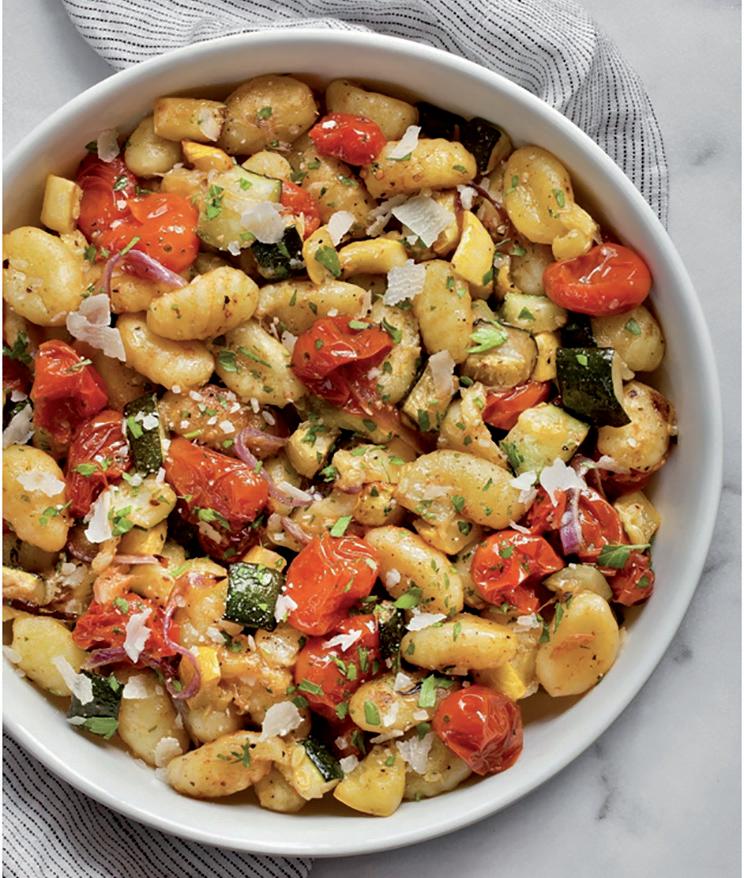
8 minute read
Jewish flavors 101
Cooking with Masha
Dear cook!
Advertisement
Time is flying way too fast. The holiday of Shavuot is upon us!
Gnocchi (two variations)
Ok, ok, I was never great at writing poetry. But cheesecake and blintzes time makes me very happy! The holiday of receiving the holy Torah. My most favourite holiday! I think this is the festival that should last 8 days, not Pesach. I’m ok with eating matzos for just two days. Really. It would bring me a lot more joy to eat cheesecake for 8 days! Can you imagine? It would be a mitzvah to eat cakes for more than a week! That would make Judaism so much more attractive to secular jews. I bet people would even want to convert just for that!
You know what? Maybe there is a good reason why Shavuot is only two days and we should eat a healthier diet for the rest of the time.. Hashem was even thinking about our waist line!
My family likes gnocchi. They are basically mashed potatoes mixed with flour and eggs and boiled as small pieces of pasta. They are not hard to make and you can make them with different vegetables, not only potatoes. But for today’s recipes we are going to be using store bought, shelf stable gnocchi. You can find them in most kosher supermarkets nowadays.
Just like pasta, gnocchi can be cooked in a variety of ways with different sauces. Here are two fun ways to make them.
Variation number 1:
2 packages of gnocchi (500 g)
3 tbsp butter
2 tbsp olive oil
4 cloves garlic, minced
1 tsp kosher salt
1/2 tsp coarse black pepper
1/3 cup dry white wine
3/4 cup heavy cream
½ cup grated parmesan cheese
Variation number 2:
2 cups of cherry tomatoes
1 sliced red onion
2 regular zucchini, cut into cubes
1 jalapeño pepper, cut to strips without the seeds, optional
4 garlic cloves
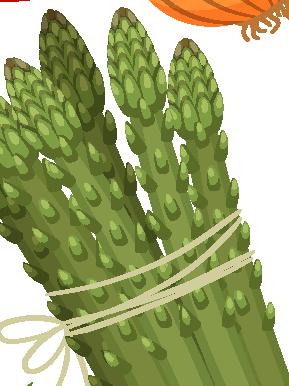
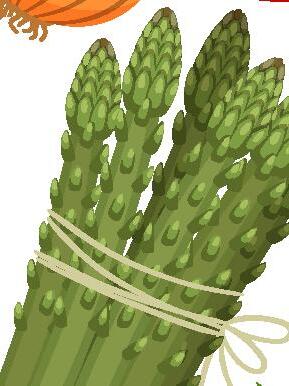
½ cup of pitted olives, or more if you are like me and love olives
1 teaspoon of dried oregano
1 teaspoon of salt
1 teaspoon of sumac

1 tablespoon of za’atar
1/4 cup of olive oil
2 packages of gnocchi (500g each)
1 cup of tomato sauce

But I am looking forward to those 2 days of indulgence. Hopefully, I will even have time to make all the scrumptious food I have written down on my menu list.
A lot of families have a tradition of having one milchig (dairy) meal on the first day of Yom Tov. That is the one I am really looking forward to! Here are some delicious options for you to consider.
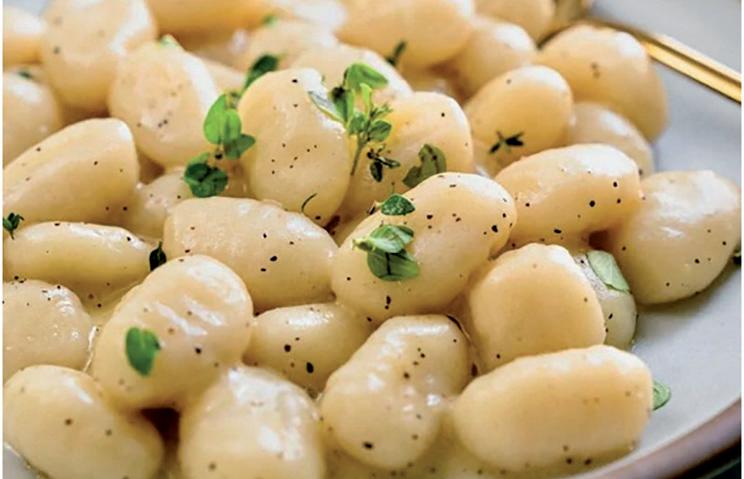
Heat a large pan over medium high heat. If you do not have a large milchig pan, do it in two batches, dividing oil and using 2 tbsp of butter for each batch. Add oil and half of the butter to the pan. When the butter is melted, add gnocchi. Mix to coat the gnocchi. Add the rest of the butter to the pan. Cook without mixing for 2 minutes. Mix and cook for another 2 minutes.
Pinch of salt
Fresh basil leaves, optional
Preheat your oven to 450°F. Line a baking sheet with parchment paper.
Add the tomatoes, zucchini, jalapeño pepper, olives, red onion, garlic cloves.
Season with salt, oregano, sumac, za’atar and olive oil. Mix it well and spread it evenly.
If you did this in two batches, put all the gnocchi into the pan. Add garlic and the spices. Cook for about 2 min, stirring frequently but gently until garlic is fragrant. Add wine, stir and cook for another minute and a half. Add cream and let it simmer for a minute or two. Sprinkle it with Parmesan cheese and serve!
Roast on a convection broil for 8-10 minutes until the vegetables are golden.
Remove from the oven and add the gnocchi and tomato sauce.
Mix it well and spread it evenly, season with a bit of salt and fresh basil.



Transfer back to the oven for 8-10 more minutes to get a nice crispy gnocchi.
Chocolate Cookies with cheese filling
sheet.
Serve it with a sprinkling of Parmesan cheese.
Chug Sameach! Until next time and happy cooking!
Pasta salad
3 cups cooked rotini or bow pasta
½ pint of grape tomatoes, cut in half
½ cup red pepper, coarsely chopped
½ cup yellow pepper, coarsely chopped
½ cup red onions, thinly sliced
2 cups baby spinach leaves
½ cup crumbled feta cheese
This is one of my daughter’s specialties. It disappears pretty fast, I must warn you.
1 cup (2 sticks) butter
½ cup sugar
½ cup brown sugar
1 teaspoon vanilla extract
2 eggs
2¼ cups flour
½ cup cocoa
1 teaspoon baking soda
1 cup chocolate chips
Cheese Filling
Scoop cookie dough into balls using a medium-sized scoop. Flatten out the dough and place a frozen cream cheese ball in the center. Mold the dough around the cream cheese ball, making sure it is completely covered.
Bake for 12-15 minutes. Let the cookies cool down completely before handling.
Cherry soup
454 g Frozen cherries, pitted
5 apples, peeled, seeded and cut into chunks
3 cups frozen blueberries

½ cup toasted pine nuts
2 tablespoons fresh flat-leaf parsley, thinly sliced (optional)
1 tablespoon fresh basil, thinly sliced (optional)
Dressing
2 tablespoons of red wine vinegar
1 garlic clove, finely chopped
¼ cup extra-virgin olive oil
Salt and black pepper, to taste
1 (8-ounce) block unwhipped cream cheese
3 cups confectioners sugar
2 tablespoons flour
1 teaspoon vanilla sugar
5 cups of pomegranate juice (can substitute 2 cups of sweet red wine for 2 cups of juice)
Juice of 1 lemon
¾ cup maple syrup or honey
250g of vanilla yogurt or leben
In a medium bowl, whisk the vinegar and garlic to blend. Slowly drizzle in the oil, and whisk until fully incorporated. Season to taste with salt and pepper.
In a large bowl, toss the pasta, tomatoes, peppers, onion, spinach leaves, feta cheese, nuts, basil and parsley with enough dressing to coat.

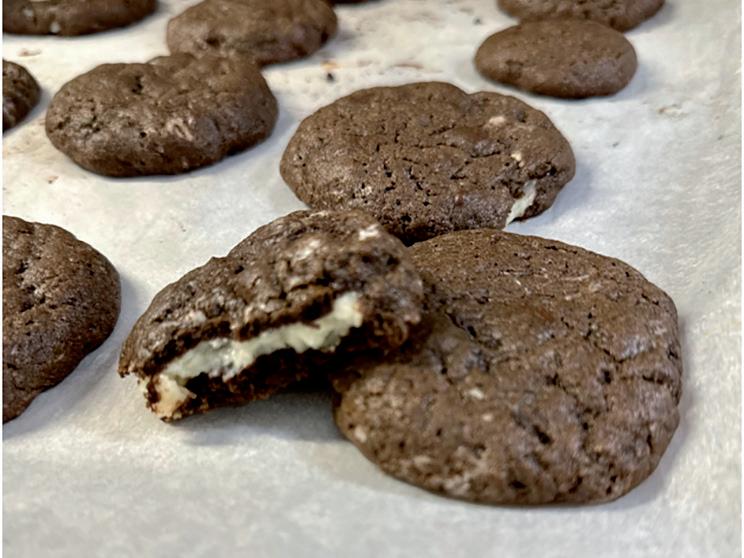
To make the filling, mix cream cheese, confectioners’ sugar, flour, and vanilla sugar. Drop tablespoonfuls onto a lined baking sheet and freeze for at least 1½ hours. Roll into balls, then return to the freezer until ready to use.
Cook cherries, blueberries and apples in the juice. Add sweetener of your choice. Bring to a boil, and then simmer for 10 minutes, until the fruit is soft. Remove a ladleful of berries and set aside. Add yogurt and purée with an immersion blender. Return berries to garnish. Serve cold.
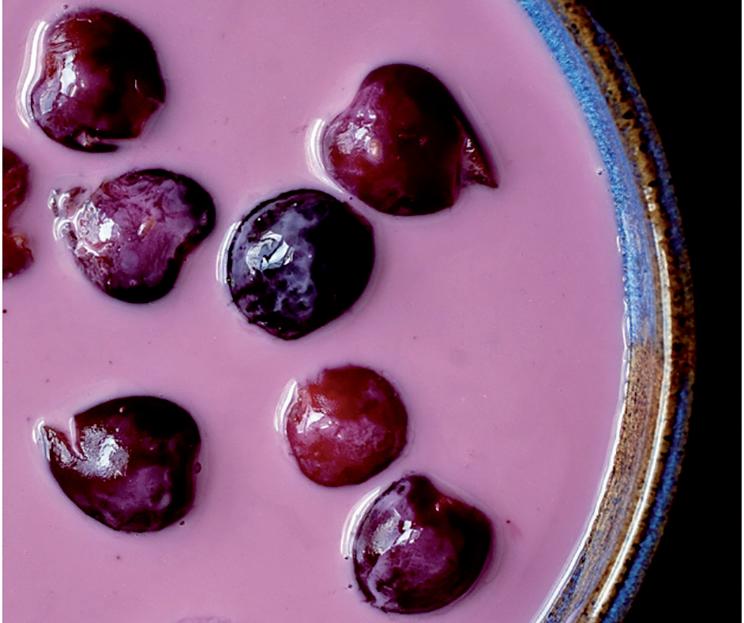
While the cream cheese filling is in the freezer, prepare the cookie dough. Cream butter and sugars, then add vanilla and eggs. Gradually add flour, cocoa, and baking soda. Mix until combined, then add chocolate chips.
Enjoy!
Chug Sameach! Until next time and happy cooking!
Preheat the oven to 350°F. Prepare a parchment lined baking
Masha Rodov
Where Is Mount Sinai?
I’ve seen lots of theories about the location of Mount Sinai. Is there any validity to those theories? I know that Judaism reveres the Temple Mount as the site of the Holy Temple, but is there any location that Judaism reveres or at least recognizes as Mount Sinai, the place where G-d gave the Torah and where the Jewish nation was born? And if not, why?
Reply
There are lots of theories, but none of them are even close to conclusive. Why is that? Why have the Jewish sages not preserved a tradition regarding the location of the most monumental event in all of history? Why the ambivalence?
Once the Jewish people received the Torah on Mount Sinai and continued their journey to the Land of Israel, there is just one biblical mention of anyone going back to Mount Sinai.
We read in the Book of Kings how, hundreds of years after the giving of the Torah, Elijah the prophet fled the wicked queen Jezebel and took refuge in a cave on “the mountain of G-d, Horeb,” which is identified as none other than Mount Sinai.
But on closer examination, this incident itself only underscores the question.
The day after Elijah took refuge, the word of G-d came to him: “What are you doing here, Elijah?”
After the prophet complained about his lot and the bad deeds of the people, G-d told him to step outside and stand on the mountainside. Elijah did so, and then, in one of the most stirring moments in Scripture, we read:
Behold! the L-rd passes, and a great and strong wind splitting mountains and shattering boulders before the L-rd—but the L-rd was not in the wind.
And after the wind, an earthquake— not in the earthquake was the L-rd.
After the earthquake, fire—not in the fire was the L-rd.
And after the fire, a still small sound.
And as Elijah heard, he wrapped his face in his mantle, and he went out and stood at the entrance to the cave, and behold a voice came to him and [again] said: “What are you doing here, Elijah?”
G-d then told him to go back to the people, with instructions on how to deal with them.
Mount Sinai was the site of great drama, but G-d told Elijah that His eternal place is not in great noises and rumbling earthquakes. Rather, He can be found in our quiet, humble day-to-day actions. His message was clear: “You don’t belong here. Go back to the people and do your work!”
Honoring the Place
Perhaps the rabbis’ attitude toward Mount Sinai can best be explained by the following piece of Talmud:
It is not the place that honors the person; rather, the person honors his place, as we found with regard to Mount Sinai, that as long as the Divine Presence rested upon it, the Torah said: “Nor let the flocks nor the herds graze before that mountain.” Once the Divine Presence departed from the mountain, the Torah said: “When the shofar sounds long, they may come up to the mountain” [indicating that the sanctity was not intrinsic to the place, but was due to the Divine Presence resting there].
Mount Sinai itself was not inherently holy. Rather, what was done there gave honor and holiness to Sinai, so once the people received the Torah and moved on, Sinai was no longer holy.
We read a similar story from the Talmud:
Rabbah bar bar Chanah said: “Once we were traveling in the desert, and we were accompanied by a certain Arab. . . . That Arab also said to me: ‘Come, I will show you Mount Sinai.’ I went and saw that scorpions were encircling it, and they were standing as high as white donkeys . . .”
The commentaries explain that scorpions represent the forces of evil. Once the Divine
Presence left the place, it became susceptible to unholiness.
Thus, though Sinai was holy during the giving of the Torah, once it had accomplished its purpose it was void of significance. At Sinai we were given a mission to learn the Torah and uplift and refine the mundane, outside world. Simply hanging around Mount Sinai would defeat the purpose.
But it does not end there.
The Return of Mount Sinai
The Talmud states that in the messianic era, all of the synagogues of the diaspora will be transported to the Land of Israel:
Rabbi Elazar HaKappar says: “In the future, the synagogues and the study halls in Babylonia will be transported and reestablished in the Land of Israel, as it is stated: ‘Surely, like Tabor among the mountains, and like Carmel by the sea, so shall he come.’There is a tradition that these mountains came to Sinai at the giving of the Torah and demanded that the Torah should be given upon them. We can therefore extrapolate: Just as Tabor and Carmel, which came only momentarily to Torah, were relocated and established in Israel in reward for their actions, all the more so should the synagogues and study halls in Babylonia, in which the Torah is read and disseminated, be relocated to Israel.”
Commentaries explain that this refers to all the synagogues from throughout the generations. Since the Divine Presence rested upon them, and they were considered holy places, their holiness is never entirely erased, and they will be transported to the Land of Israel.
In a fascinating talk, the Lubavitcher Rebbe explains that if this is true for all the synagogues and houses of Torah learning, then it is surely true for Mount Sinai itself, which was in a sense responsible for all the future generations’ learning of Torah and performance of mitzvahs. Thus, in the messianic era, Mount Sinai will regain its holiness and be transported to the Land of Israel.
May it be speedily in our days!



